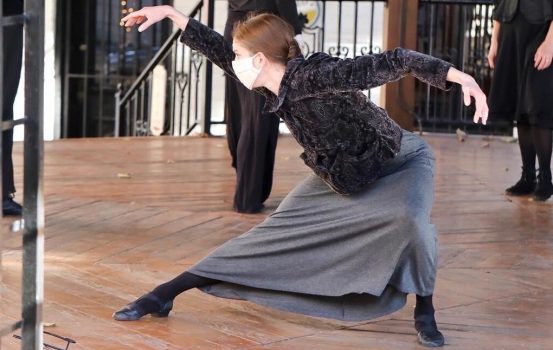ST. LOUIS—When the Big Muddy Dance Company made Lemp Legends for the Edison Theatre in 2018, I would bet, dollars to donuts, they expected to remount it at some point. What they likely didn’t expect was a re-imagination quite like this.
Lemp Legends marks many firsts for Big Muddy. It was their first full-length work and first attempt at narrative storytelling. The remount, originally planned as a site-specific, roaming performance and complementary film version, streamable now online, was also a first for the 10-year-old contemporary company.
With new restrictions in place resulting from recent spikes in coronavirus infections, the live version—scheduled to run Nov. 20-22 traveling between Lemp Mansion and Lemp Grand Hall—is now postponed to April. Sadly, cancellations and postponements are par for the course in 2020. But any dance fan with an internet connection can now tap into St. Louis folklore by viewing Lemp Legends online.
Lemp Mansion itself, the main star of the film, provides a superb setting for this serial story ballet about its original inhabitants, the Lemps. While the family and their eponymous brewery are not well known outside St. Louis, in its heyday, Lemp Brewery rivaled beer giant Anheuser-Busch. Having dissolved in 1920, sections of the original brewery in Marine Villa now serve as tourist attractions, multi-use commercial space and art studios; the family home is a restaurant and guest house—and the site of Big Muddy’s first major dance film.
There are hints of our modern times scattered throughout the film—a flatscreen TV in one of the bedrooms, for example, and social distancing recommendations on the front doors of the estate—but in general Lemp Legends successfully transports viewers to peak 19th-Century St. Louis aristocracy.
A handful of the Lemps met untimely deaths; their stories form the chapters of Lemp Legends, each less than 10 minutes a piece. Narration by John Magaña introduces each character, overlapping a terrifically scored music compilation. Delicate piano ebbs as each story climaxes, replaced by crescendoing strings or electric organ. An almost-but-not-quite horror movie vibe completes a chapter as the camera shifts to the next vignette.
The first scene is with Charles Lemp (danced in Cast A by Brandon Fink) and his dog, Cerva. Jessie Philbrick plays the role of Charles’ trusted four-legged friend; her ruddy brown skirt and blouse hint at the canine character, though the dancing fortunately takes the form of a sometimes playful, sometimes tender pas de deux. Fink clearly portrays a tortured man, grasping at his chest and arm, or melting, weak-kneed, into the floor as he paces about his room. Indeed, Charles Lemp shot his dog before turning the gun on himself, leaving a note on May 9, 1949: “In case I am found dead blame it on no one but me. Ch. A. Lemp.”
Elsa Lemp (CJ Burroughs) goes next, sister to Charles and the youngest of patriarch William Lemp’s eight children. Her rocky, on-again-off-again marriage to Thomas Wright (Enrique Herrera) came to an abrupt end when Elsa, too, killed herself—through many have questioned if that is actually how she died. Burroughs and Herrera’s duet, over and around a large, damask-covered bed, hints at a more sullen ambivalence in Wright and Lemp’s relationship, though it’s clear Elsa is metaphorically trapped, if not literally, in an unhappy marriage, simultaneously at war with herself.
The film then profiles William Sr. (Geoffrey Alexander) and the Lemp matriarch, Julia (Ellen Reed), who boogie in formal wear to Maple Leaf Rag in the dining room until Alexander, seated facing away from the camera, dances a beautiful but tragic portrayal of the man’s devolution and decline until he, too, takes his life. Reed then dances a sorrow-filled solo, appearing to embrace and tango with her husband, now gone.
A contemporary dance version of a polka at the Lemp Mansion bar, performed by the Big Muddy trainees, brings a bit of lightness and levity to the middle of the film, as does a blithe scene by high-school aged performers from the Elevate Student Project—sandwiching a funeral dance in the biergarten for favorite son Frederick, who died from health complications at age 28—before forging into a final montage: a ball hosted by St. Louis socialites Billy and Lillian Lemp (a bickering, boisterous couple delightfully danced by Kelly Schneider and Dustin Crumbaugh), staged at Lemp Grand Hall.
Tree 9 Films’ gorgeous camera work consists mainly of static shots of each room, which I imagine are quite small but look grand from these vantage points. A few roaming sequences trace the hallways of the Lemp’s estate and peek into their rooms, to great effect; it’s as though we are voyeurs of the most private moments of their lives.
I keep looking for examples of dance on film—which will continue to be the norm for the near future, at least—that feel like a palatable replacement for watching dance live. With few exceptions, Lemp Legends provides the strongest evidence thus far that good dance is possible (enjoyable, even) in a pandemic. But that might not have been the case if, like so many others, they’d taken the filmmaking part less seriously. Nothing replaces live. Lemp Legends comes pretty darn close.
—
Lemp Legends is available online until Nov. 30 at thebigmuddydanceco.org/lemp/. Tickets to stream the film are $20. Ticket holders who planned to attend the live performance Nov. 20-22 may redeem their tickets in late April, with new show dates and details to be announced.
Header photo: Big Muddy Dance Company at Lemp Mansion, photo credit: Carly Vanderheyden
